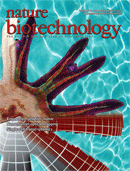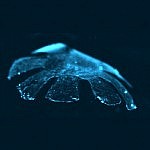Creating an artificial jellyfish to model the human heart
 Regular blog readers will know I think tissue engineering is an exciting area where you can see innovation in action – advances in basic science can translate into ways to artificially create replacement organs and body parts.
Regular blog readers will know I think tissue engineering is an exciting area where you can see innovation in action – advances in basic science can translate into ways to artificially create replacement organs and body parts.
Research published online 22 July 2012 in Nature Biotechnology by Janna Nawroth and colleagues at the California Institute of Technology (Caltech) and Harvard University, shows how biomedical engineers are learning from the structure and function of other animals.

Credit: Caltech and Harvard University
They achieved this by forming the elastomer into a medusoid or jellyfish like shape with eight lobes around a central disc, then applying a monolayer of rat cardiac muscle tissue, which when electrically shocked, contracted in a synchronized way.
The net result was the medusoid “swam” in a similar way to a jellyfish. They effectively developed an artificial pump made out of a hybrid of living cells and silicone rubber.
The video below by Janna Nawroth, produced by Caltech and Harvard University, shows the medusoid in action, and explains how this research advances the design of muscular pumps for biomedical application:
While we are not yet able to tissue engineer a replacement human heart, it’s hard not to believe that at some point in the future we will see the development of hybrid devices that combine synthetic materials and cultured heart muscle cells.
Reference
![]() Janna C Nawroth, Hyungsuk Lee, Adam W Feinberg, Crystal M Ripplinger, Megan L McCain, Anna Grosberg, John O Dabiri, & Kevin Kit Parker (2012). A tissue-engineered jellyfish with biomimetic propulsion Nature Biotechnology, 30, 792-797 DOI: 10.1038/nbt.2269
Janna C Nawroth, Hyungsuk Lee, Adam W Feinberg, Crystal M Ripplinger, Megan L McCain, Anna Grosberg, John O Dabiri, & Kevin Kit Parker (2012). A tissue-engineered jellyfish with biomimetic propulsion Nature Biotechnology, 30, 792-797 DOI: 10.1038/nbt.2269